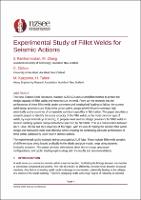Experimental and Analytical Study of Fillet Welds for Seismic Actions

Download
Date
2024-04-09Authors
Ramhormozian, Shahab
Zhang, Mark
Clifton, Charles
Karpenko, Michail
Taheri, Hafez
Metadata
Show full item recordAbstract
New Zealand steel standards NZS3404 uses a simplified method to predict the weld design capacity and to size the weld. According to the industry feedback on the design and manufacturing of the seismic welded connections, the current weld design provisions are likely to be conservative compared with those in overseas countries of comparable technical capability in fabrication and seismicity. This paper is about a research project to identify the actual capacity of the fillet welds, as the most common type of welds, by experimental cyclic testing, to propose more realistic design provisions for fillet welds in seismic resisting systems compared to those specified by NZS3404. This is a collaboration between AUT, UoA, HERA, and University of Michigan with the aim of making the seismic fillet welds design and fabrication more cost-effective while ensuring adequate performance of these welds, particularly under severe seismic actions.
The experimental cyclic testing is conducted at AUT labs. These include fillet weld samples of different sizes being loaded cyclically in the elastic and post-elastic range using dynamic hydraulic actuators. Finite element numerical models of the samples are also created and validated by the experiments to be analyzed to expand the investigations. The cyclically tested and fractured samples were evaluated from the fractographic and metallurgical points of view. This paper provides a background of the fillet weld design provisions, followed by presenting recent developments in this field. Finally, the test setup design, specimens’ configurations, and designed cyclic loading regime are explained along with the results and recommendations.
